CHC52015 Diploma: Recognising and Responding to Crisis Situations
VerifiedAdded on 2023/06/17
|29
|8904
|222
Homework Assignment
AI Summary
This student assessment workbook focuses on the competency CHCCCS019, 'Recognise and respond to crisis situations,' within the CHC52015 Diploma of Community Services. It includes an overview of the unit, topics covered, and assessment tasks designed to evaluate the student's knowledge and skills in crisis intervention. The assessment covers legal and ethical considerations, types of crisis situations, indicators of crisis, and principles of self-care. Activities involve identifying signs of safety issues and responding appropriately, including a case study involving a social worker supporting a client with anxiety and depression. The workbook emphasizes the importance of adhering to safety precautions and understanding direct indicators of safety issues.
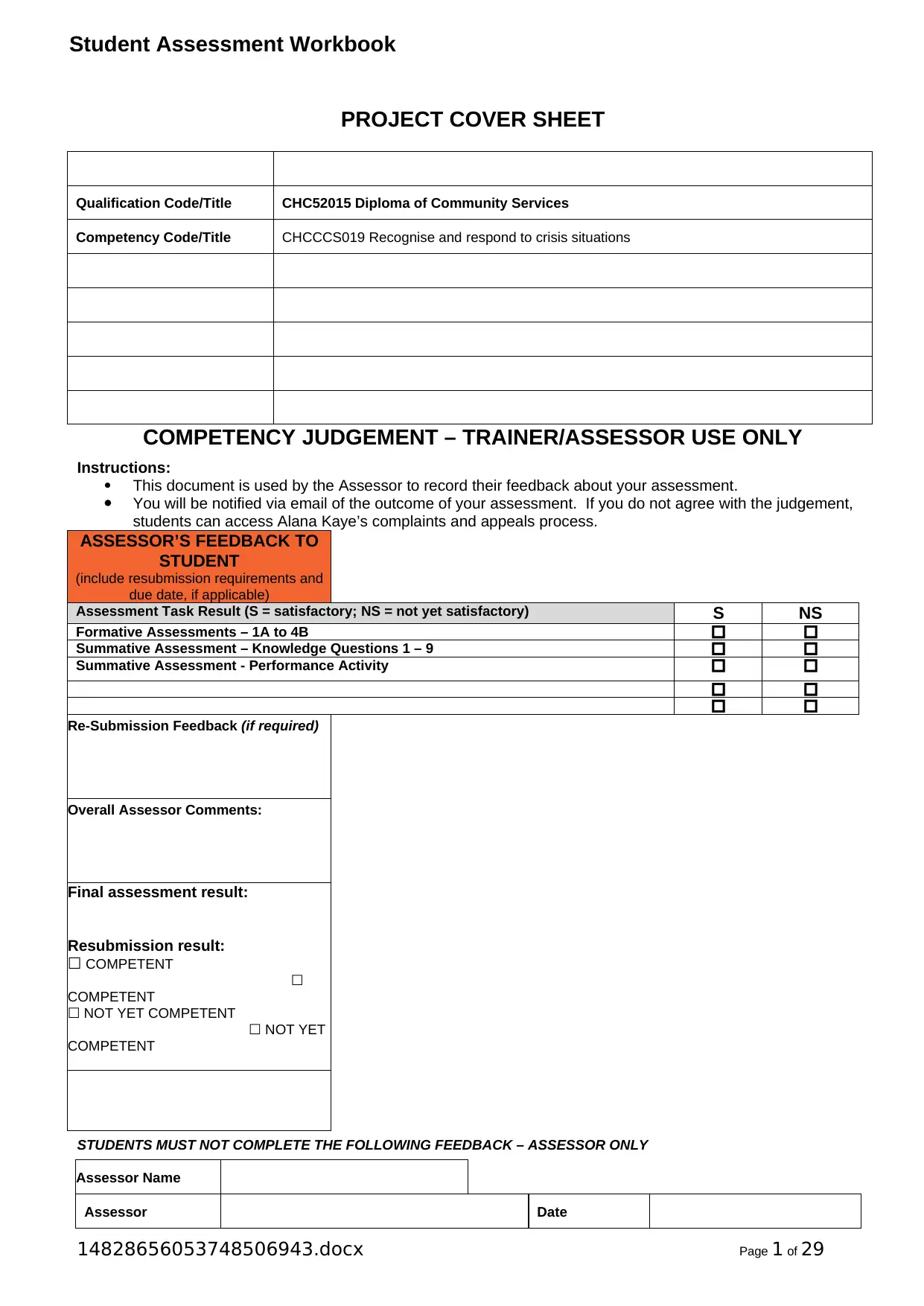
Student Assessment Workbook
PROJECT COVER SHEET
Qualification Code/Title CHC52015 Diploma of Community Services
Competency Code/Title CHCCCS019 Recognise and respond to crisis situations
COMPETENCY JUDGEMENT – TRAINER/ASSESSOR USE ONLY
Instructions:
This document is used by the Assessor to record their feedback about your assessment.
You will be notified via email of the outcome of your assessment. If you do not agree with the judgement,
students can access Alana Kaye’s complaints and appeals process.
ASSESSOR’S FEEDBACK TO
STUDENT
(include resubmission requirements and
due date, if applicable)
Assessment Task Result (S = satisfactory; NS = not yet satisfactory) S NS
Formative Assessments – 1A to 4B □ □
Summative Assessment – Knowledge Questions 1 – 9 □ □
Summative Assessment - Performance Activity □ □
□ □
□ □
Re-Submission Feedback (if required)
Overall Assessor Comments:
Final assessment result:
Resubmission result:
☐ COMPETENT
☐
COMPETENT
☐ NOT YET COMPETENT
☐ NOT YET
COMPETENT
STUDENTS MUST NOT COMPLETE THE FOLLOWING FEEDBACK – ASSESSOR ONLY
Assessor Name
Assessor Date
14828656053748506943.docx Page 1 of 29
PROJECT COVER SHEET
Qualification Code/Title CHC52015 Diploma of Community Services
Competency Code/Title CHCCCS019 Recognise and respond to crisis situations
COMPETENCY JUDGEMENT – TRAINER/ASSESSOR USE ONLY
Instructions:
This document is used by the Assessor to record their feedback about your assessment.
You will be notified via email of the outcome of your assessment. If you do not agree with the judgement,
students can access Alana Kaye’s complaints and appeals process.
ASSESSOR’S FEEDBACK TO
STUDENT
(include resubmission requirements and
due date, if applicable)
Assessment Task Result (S = satisfactory; NS = not yet satisfactory) S NS
Formative Assessments – 1A to 4B □ □
Summative Assessment – Knowledge Questions 1 – 9 □ □
Summative Assessment - Performance Activity □ □
□ □
□ □
Re-Submission Feedback (if required)
Overall Assessor Comments:
Final assessment result:
Resubmission result:
☐ COMPETENT
☐
COMPETENT
☐ NOT YET COMPETENT
☐ NOT YET
COMPETENT
STUDENTS MUST NOT COMPLETE THE FOLLOWING FEEDBACK – ASSESSOR ONLY
Assessor Name
Assessor Date
14828656053748506943.docx Page 1 of 29
Paraphrase This Document
Need a fresh take? Get an instant paraphrase of this document with our AI Paraphraser
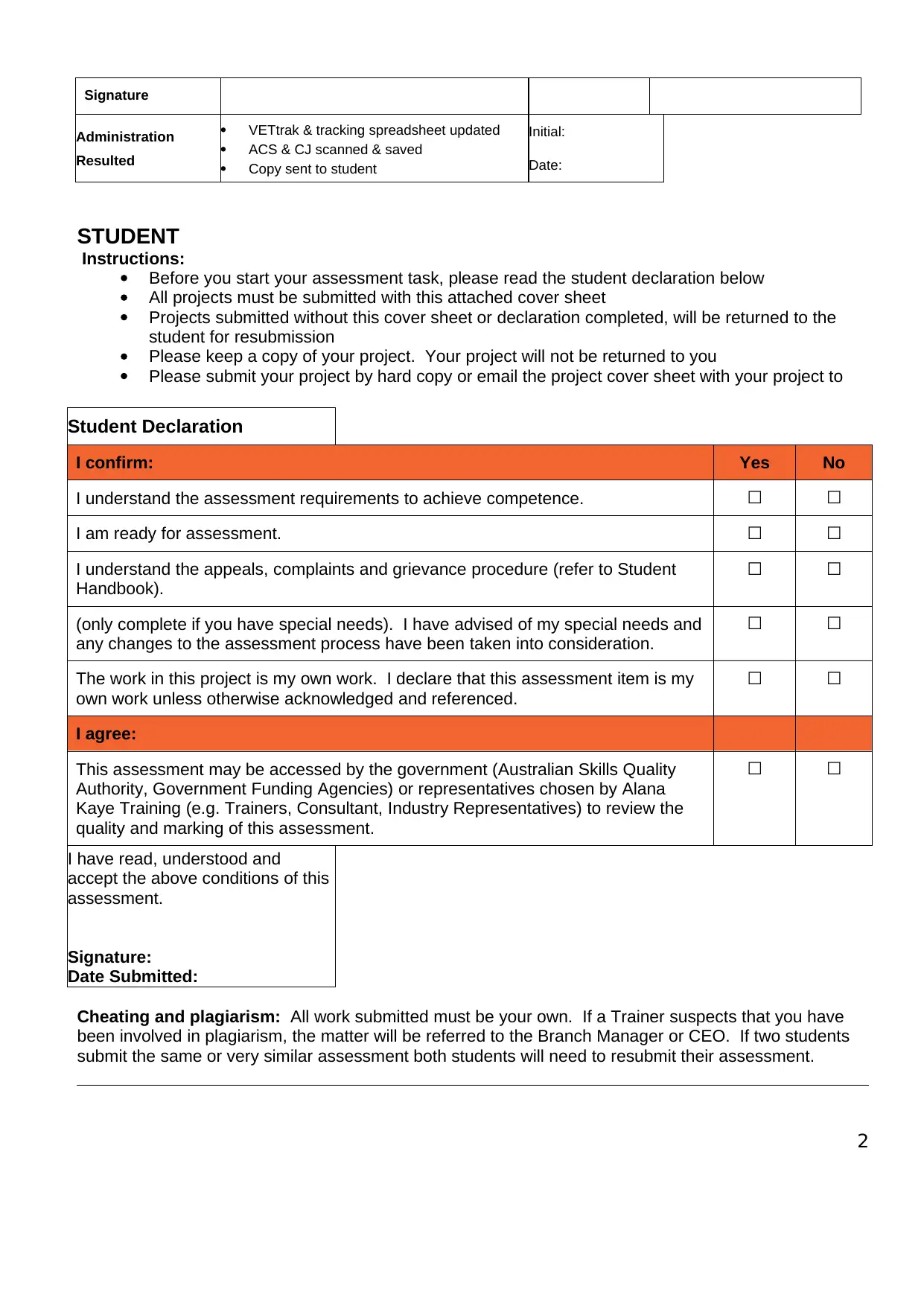
Signature
Administration
Resulted
VETtrak & tracking spreadsheet updated
ACS & CJ scanned & saved
Copy sent to student
Initial:
Date:
STUDENT
Instructions:
Before you start your assessment task, please read the student declaration below
All projects must be submitted with this attached cover sheet
Projects submitted without this cover sheet or declaration completed, will be returned to the
student for resubmission
Please keep a copy of your project. Your project will not be returned to you
Please submit your project by hard copy or email the project cover sheet with your project to
Student Declaration
I confirm: Yes No
I understand the assessment requirements to achieve competence. ☐ ☐
I am ready for assessment. ☐ ☐
I understand the appeals, complaints and grievance procedure (refer to Student
Handbook).
☐ ☐
(only complete if you have special needs). I have advised of my special needs and
any changes to the assessment process have been taken into consideration.
☐ ☐
The work in this project is my own work. I declare that this assessment item is my
own work unless otherwise acknowledged and referenced.
☐ ☐
I agree:
This assessment may be accessed by the government (Australian Skills Quality
Authority, Government Funding Agencies) or representatives chosen by Alana
Kaye Training (e.g. Trainers, Consultant, Industry Representatives) to review the
quality and marking of this assessment.
☐ ☐
I have read, understood and
accept the above conditions of this
assessment.
Signature:
Date Submitted:
Cheating and plagiarism: All work submitted must be your own. If a Trainer suspects that you have
been involved in plagiarism, the matter will be referred to the Branch Manager or CEO. If two students
submit the same or very similar assessment both students will need to resubmit their assessment.
2
Administration
Resulted
VETtrak & tracking spreadsheet updated
ACS & CJ scanned & saved
Copy sent to student
Initial:
Date:
STUDENT
Instructions:
Before you start your assessment task, please read the student declaration below
All projects must be submitted with this attached cover sheet
Projects submitted without this cover sheet or declaration completed, will be returned to the
student for resubmission
Please keep a copy of your project. Your project will not be returned to you
Please submit your project by hard copy or email the project cover sheet with your project to
Student Declaration
I confirm: Yes No
I understand the assessment requirements to achieve competence. ☐ ☐
I am ready for assessment. ☐ ☐
I understand the appeals, complaints and grievance procedure (refer to Student
Handbook).
☐ ☐
(only complete if you have special needs). I have advised of my special needs and
any changes to the assessment process have been taken into consideration.
☐ ☐
The work in this project is my own work. I declare that this assessment item is my
own work unless otherwise acknowledged and referenced.
☐ ☐
I agree:
This assessment may be accessed by the government (Australian Skills Quality
Authority, Government Funding Agencies) or representatives chosen by Alana
Kaye Training (e.g. Trainers, Consultant, Industry Representatives) to review the
quality and marking of this assessment.
☐ ☐
I have read, understood and
accept the above conditions of this
assessment.
Signature:
Date Submitted:
Cheating and plagiarism: All work submitted must be your own. If a Trainer suspects that you have
been involved in plagiarism, the matter will be referred to the Branch Manager or CEO. If two students
submit the same or very similar assessment both students will need to resubmit their assessment.
2
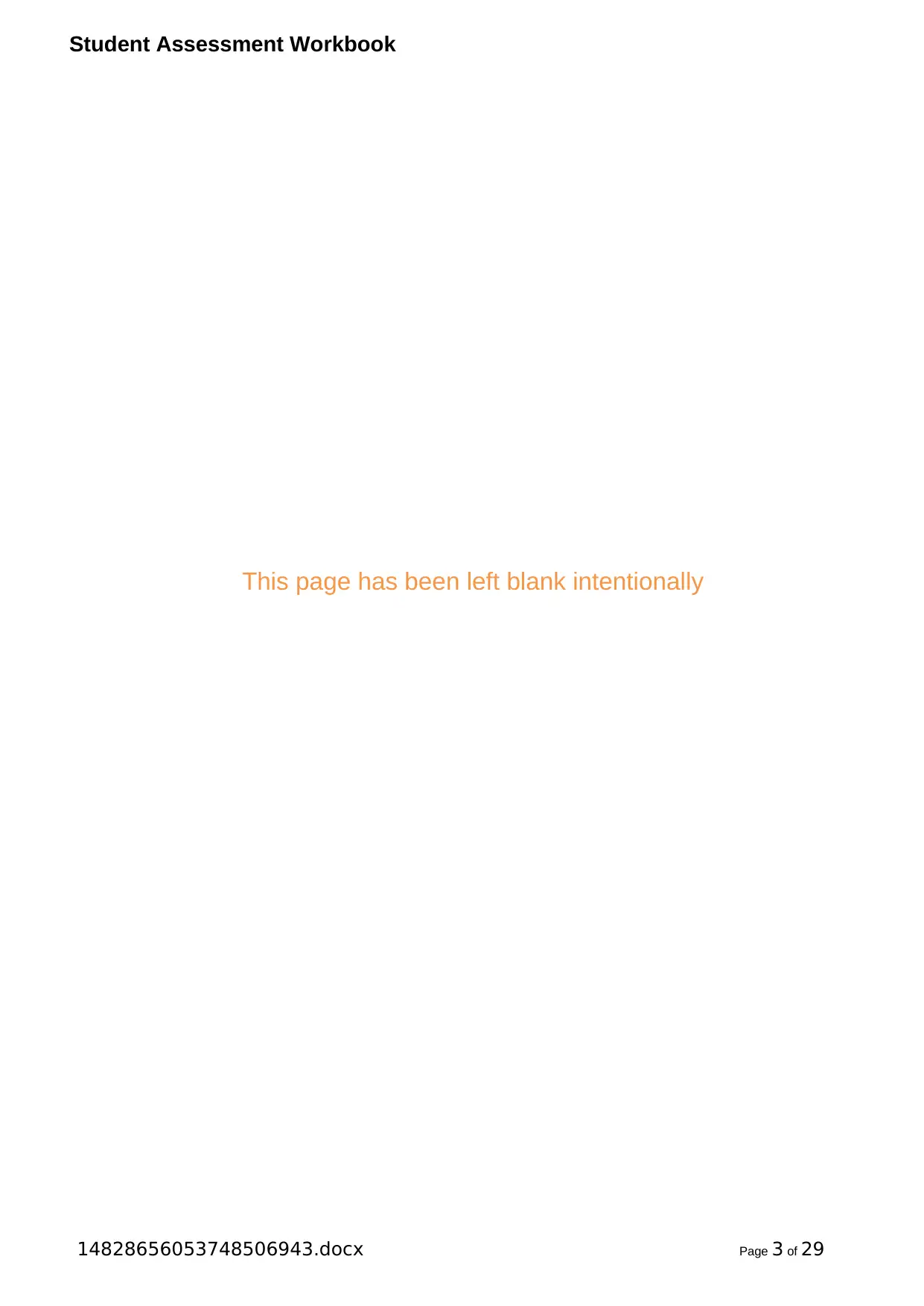
Student Assessment Workbook
This page has been left blank intentionally
14828656053748506943.docx Page 3 of 29
This page has been left blank intentionally
14828656053748506943.docx Page 3 of 29
⊘ This is a preview!⊘
Do you want full access?
Subscribe today to unlock all pages.

Trusted by 1+ million students worldwide
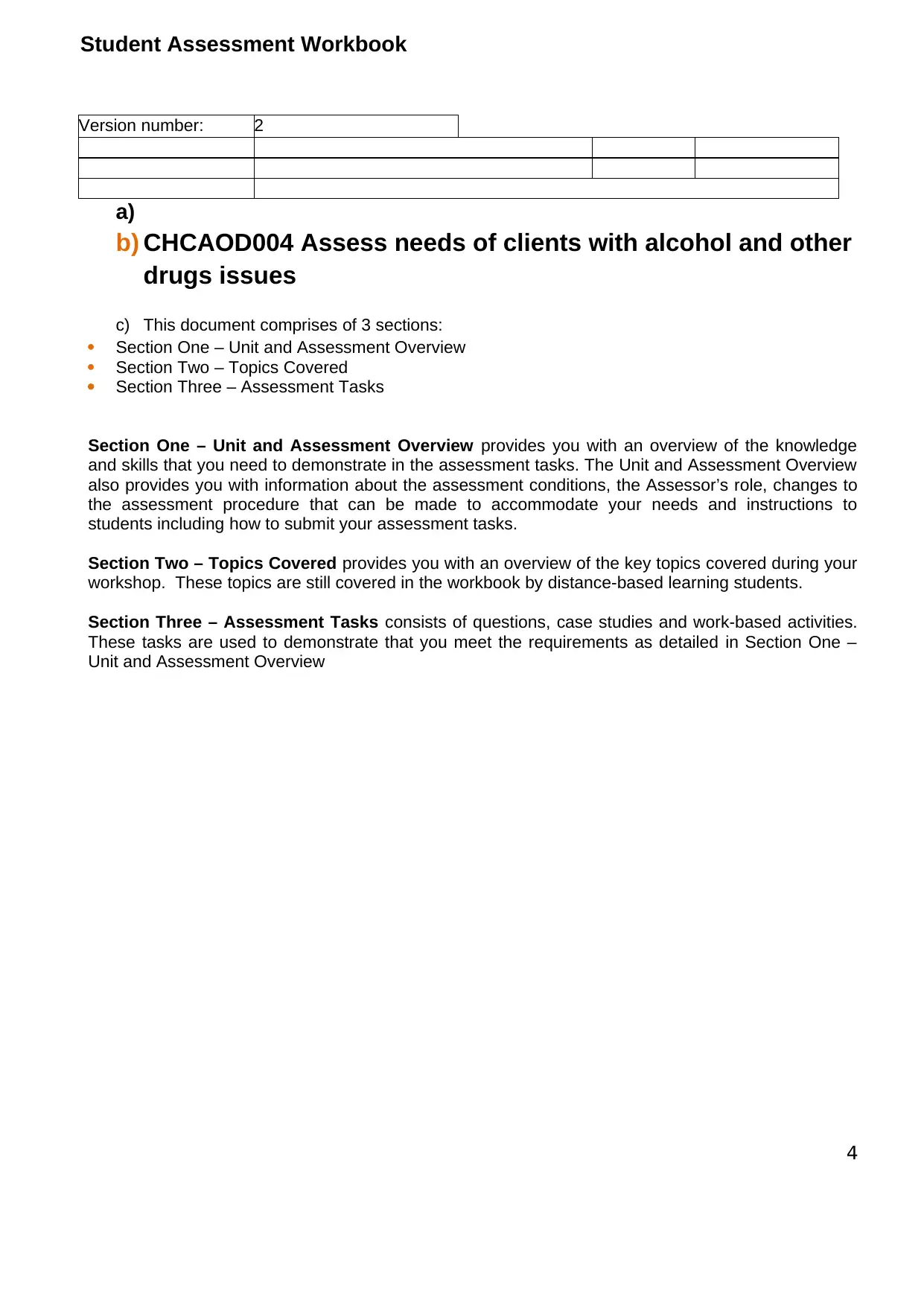
Student Assessment Workbook
Version number: 2
a)
b) CHCAOD004 Assess needs of clients with alcohol and other
drugs issues
c) This document comprises of 3 sections:
Section One – Unit and Assessment Overview
Section Two – Topics Covered
Section Three – Assessment Tasks
Section One – Unit and Assessment Overview provides you with an overview of the knowledge
and skills that you need to demonstrate in the assessment tasks. The Unit and Assessment Overview
also provides you with information about the assessment conditions, the Assessor’s role, changes to
the assessment procedure that can be made to accommodate your needs and instructions to
students including how to submit your assessment tasks.
Section Two – Topics Covered provides you with an overview of the key topics covered during your
workshop. These topics are still covered in the workbook by distance-based learning students.
Section Three – Assessment Tasks consists of questions, case studies and work-based activities.
These tasks are used to demonstrate that you meet the requirements as detailed in Section One –
Unit and Assessment Overview
4
Version number: 2
a)
b) CHCAOD004 Assess needs of clients with alcohol and other
drugs issues
c) This document comprises of 3 sections:
Section One – Unit and Assessment Overview
Section Two – Topics Covered
Section Three – Assessment Tasks
Section One – Unit and Assessment Overview provides you with an overview of the knowledge
and skills that you need to demonstrate in the assessment tasks. The Unit and Assessment Overview
also provides you with information about the assessment conditions, the Assessor’s role, changes to
the assessment procedure that can be made to accommodate your needs and instructions to
students including how to submit your assessment tasks.
Section Two – Topics Covered provides you with an overview of the key topics covered during your
workshop. These topics are still covered in the workbook by distance-based learning students.
Section Three – Assessment Tasks consists of questions, case studies and work-based activities.
These tasks are used to demonstrate that you meet the requirements as detailed in Section One –
Unit and Assessment Overview
4
Paraphrase This Document
Need a fresh take? Get an instant paraphrase of this document with our AI Paraphraser
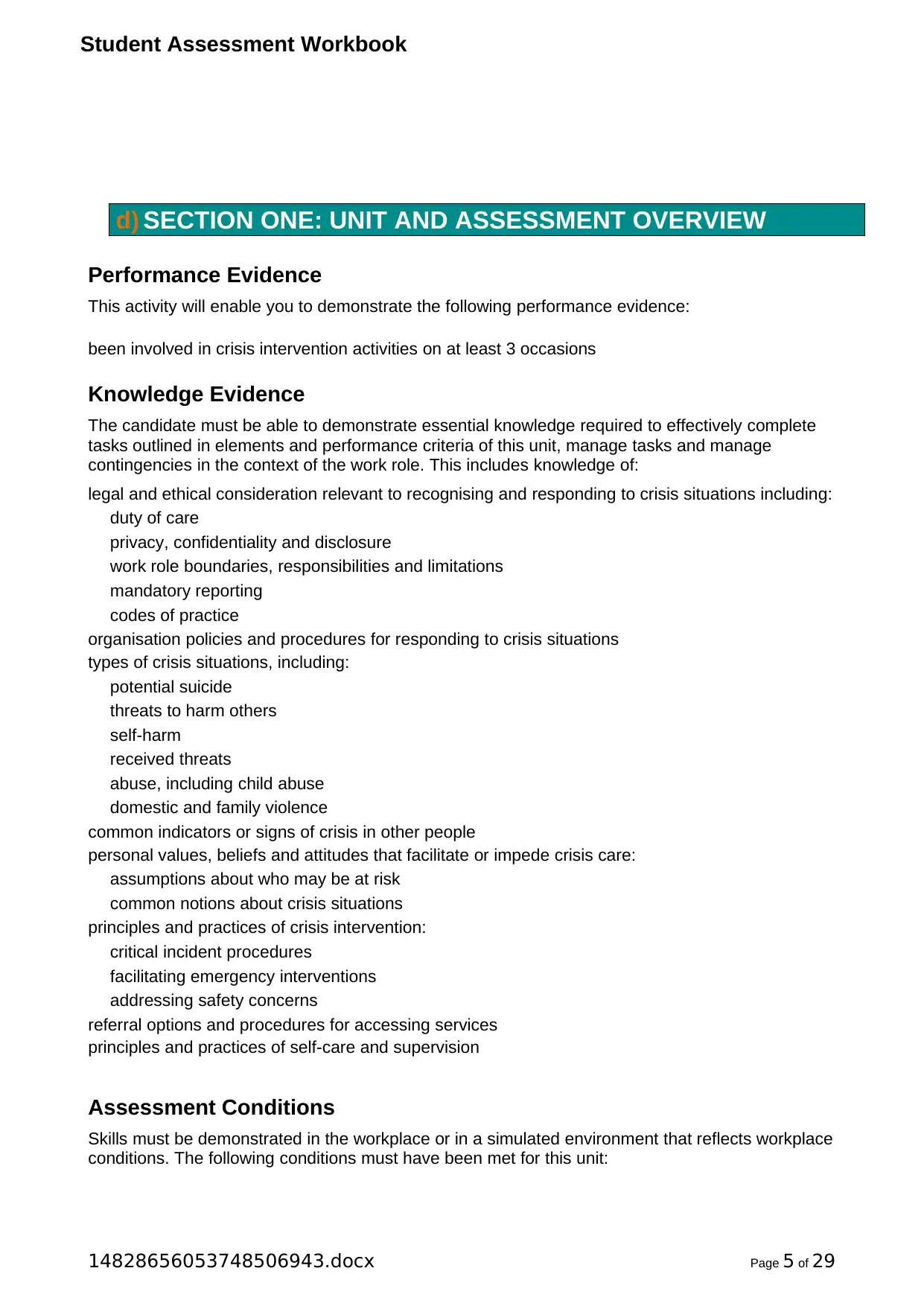
Student Assessment Workbook
d) SECTION ONE: UNIT AND ASSESSMENT OVERVIEW
Performance Evidence
This activity will enable you to demonstrate the following performance evidence:
been involved in crisis intervention activities on at least 3 occasions
Knowledge Evidence
The candidate must be able to demonstrate essential knowledge required to effectively complete
tasks outlined in elements and performance criteria of this unit, manage tasks and manage
contingencies in the context of the work role. This includes knowledge of:
legal and ethical consideration relevant to recognising and responding to crisis situations including:
duty of care
privacy, confidentiality and disclosure
work role boundaries, responsibilities and limitations
mandatory reporting
codes of practice
organisation policies and procedures for responding to crisis situations
types of crisis situations, including:
potential suicide
threats to harm others
self-harm
received threats
abuse, including child abuse
domestic and family violence
common indicators or signs of crisis in other people
personal values, beliefs and attitudes that facilitate or impede crisis care:
assumptions about who may be at risk
common notions about crisis situations
principles and practices of crisis intervention:
critical incident procedures
facilitating emergency interventions
addressing safety concerns
referral options and procedures for accessing services
principles and practices of self-care and supervision
Assessment Conditions
Skills must be demonstrated in the workplace or in a simulated environment that reflects workplace
conditions. The following conditions must have been met for this unit:
14828656053748506943.docx Page 5 of 29
d) SECTION ONE: UNIT AND ASSESSMENT OVERVIEW
Performance Evidence
This activity will enable you to demonstrate the following performance evidence:
been involved in crisis intervention activities on at least 3 occasions
Knowledge Evidence
The candidate must be able to demonstrate essential knowledge required to effectively complete
tasks outlined in elements and performance criteria of this unit, manage tasks and manage
contingencies in the context of the work role. This includes knowledge of:
legal and ethical consideration relevant to recognising and responding to crisis situations including:
duty of care
privacy, confidentiality and disclosure
work role boundaries, responsibilities and limitations
mandatory reporting
codes of practice
organisation policies and procedures for responding to crisis situations
types of crisis situations, including:
potential suicide
threats to harm others
self-harm
received threats
abuse, including child abuse
domestic and family violence
common indicators or signs of crisis in other people
personal values, beliefs and attitudes that facilitate or impede crisis care:
assumptions about who may be at risk
common notions about crisis situations
principles and practices of crisis intervention:
critical incident procedures
facilitating emergency interventions
addressing safety concerns
referral options and procedures for accessing services
principles and practices of self-care and supervision
Assessment Conditions
Skills must be demonstrated in the workplace or in a simulated environment that reflects workplace
conditions. The following conditions must have been met for this unit:
14828656053748506943.docx Page 5 of 29
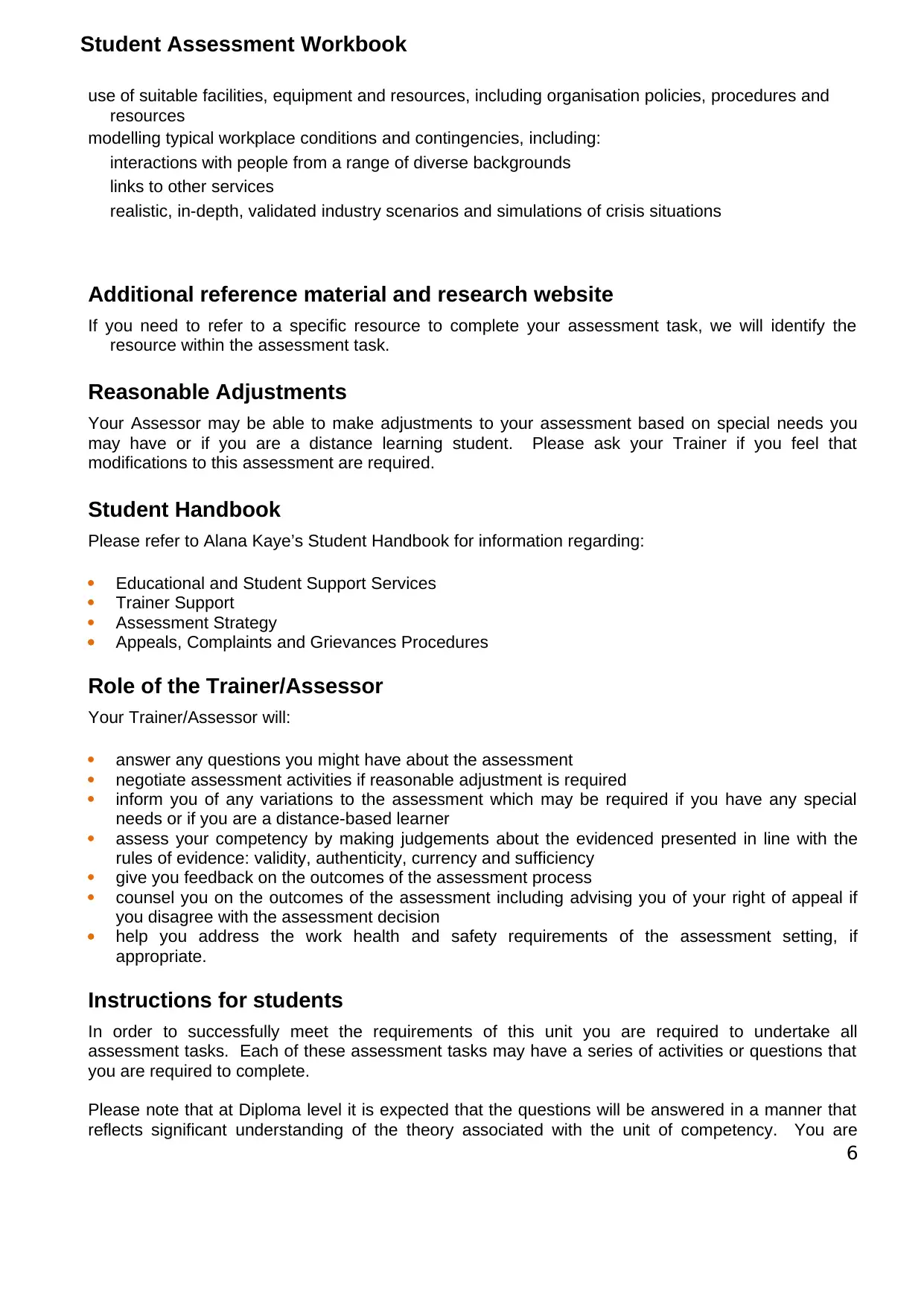
Student Assessment Workbook
use of suitable facilities, equipment and resources, including organisation policies, procedures and
resources
modelling typical workplace conditions and contingencies, including:
interactions with people from a range of diverse backgrounds
links to other services
realistic, in-depth, validated industry scenarios and simulations of crisis situations
Additional reference material and research website
If you need to refer to a specific resource to complete your assessment task, we will identify the
resource within the assessment task.
Reasonable Adjustments
Your Assessor may be able to make adjustments to your assessment based on special needs you
may have or if you are a distance learning student. Please ask your Trainer if you feel that
modifications to this assessment are required.
Student Handbook
Please refer to Alana Kaye’s Student Handbook for information regarding:
Educational and Student Support Services
Trainer Support
Assessment Strategy
Appeals, Complaints and Grievances Procedures
Role of the Trainer/Assessor
Your Trainer/Assessor will:
answer any questions you might have about the assessment
negotiate assessment activities if reasonable adjustment is required
inform you of any variations to the assessment which may be required if you have any special
needs or if you are a distance-based learner
assess your competency by making judgements about the evidenced presented in line with the
rules of evidence: validity, authenticity, currency and sufficiency
give you feedback on the outcomes of the assessment process
counsel you on the outcomes of the assessment including advising you of your right of appeal if
you disagree with the assessment decision
help you address the work health and safety requirements of the assessment setting, if
appropriate.
Instructions for students
In order to successfully meet the requirements of this unit you are required to undertake all
assessment tasks. Each of these assessment tasks may have a series of activities or questions that
you are required to complete.
Please note that at Diploma level it is expected that the questions will be answered in a manner that
reflects significant understanding of the theory associated with the unit of competency. You are
6
use of suitable facilities, equipment and resources, including organisation policies, procedures and
resources
modelling typical workplace conditions and contingencies, including:
interactions with people from a range of diverse backgrounds
links to other services
realistic, in-depth, validated industry scenarios and simulations of crisis situations
Additional reference material and research website
If you need to refer to a specific resource to complete your assessment task, we will identify the
resource within the assessment task.
Reasonable Adjustments
Your Assessor may be able to make adjustments to your assessment based on special needs you
may have or if you are a distance learning student. Please ask your Trainer if you feel that
modifications to this assessment are required.
Student Handbook
Please refer to Alana Kaye’s Student Handbook for information regarding:
Educational and Student Support Services
Trainer Support
Assessment Strategy
Appeals, Complaints and Grievances Procedures
Role of the Trainer/Assessor
Your Trainer/Assessor will:
answer any questions you might have about the assessment
negotiate assessment activities if reasonable adjustment is required
inform you of any variations to the assessment which may be required if you have any special
needs or if you are a distance-based learner
assess your competency by making judgements about the evidenced presented in line with the
rules of evidence: validity, authenticity, currency and sufficiency
give you feedback on the outcomes of the assessment process
counsel you on the outcomes of the assessment including advising you of your right of appeal if
you disagree with the assessment decision
help you address the work health and safety requirements of the assessment setting, if
appropriate.
Instructions for students
In order to successfully meet the requirements of this unit you are required to undertake all
assessment tasks. Each of these assessment tasks may have a series of activities or questions that
you are required to complete.
Please note that at Diploma level it is expected that the questions will be answered in a manner that
reflects significant understanding of the theory associated with the unit of competency. You are
6
⊘ This is a preview!⊘
Do you want full access?
Subscribe today to unlock all pages.

Trusted by 1+ million students worldwide
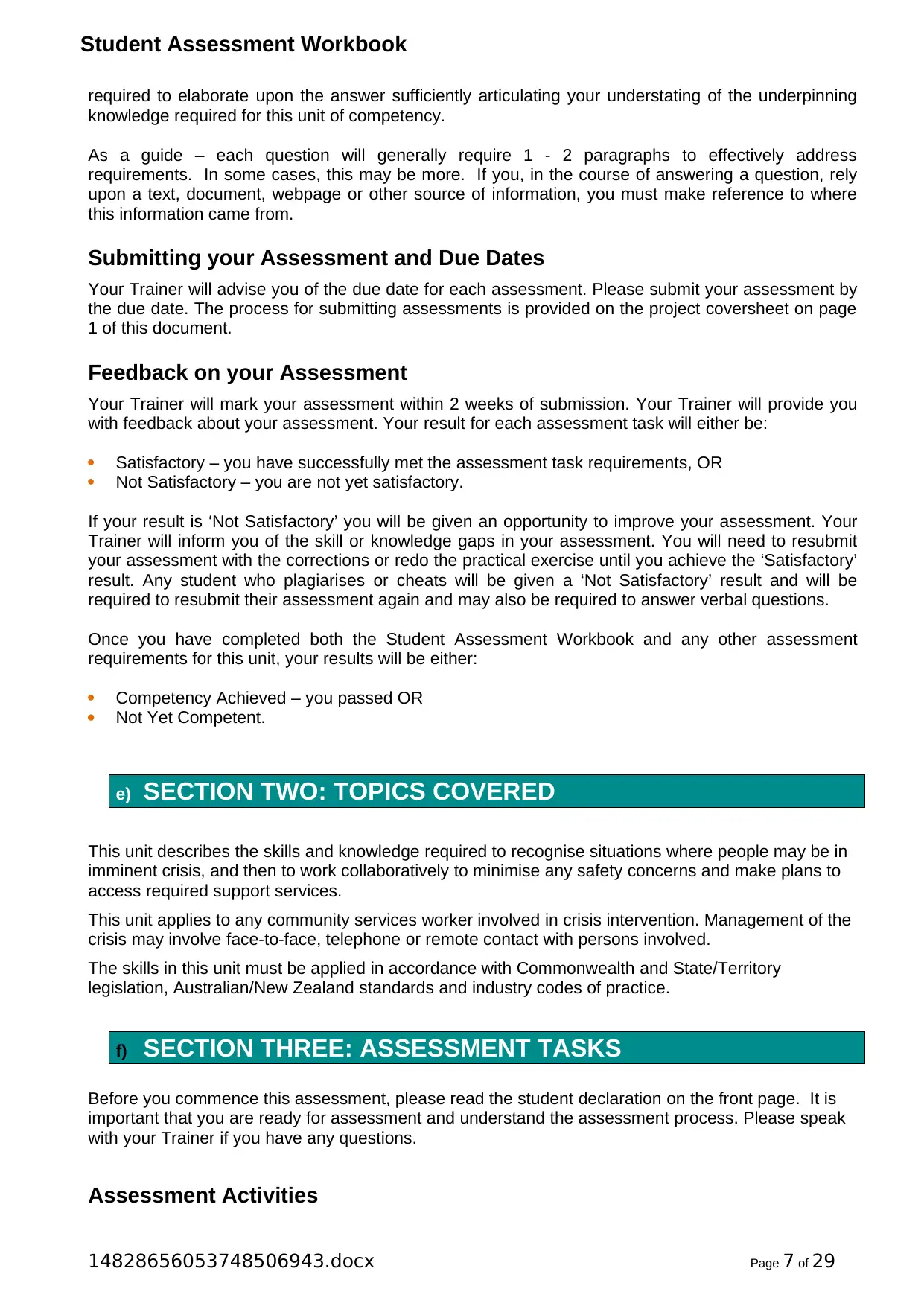
Student Assessment Workbook
required to elaborate upon the answer sufficiently articulating your understating of the underpinning
knowledge required for this unit of competency.
As a guide – each question will generally require 1 - 2 paragraphs to effectively address
requirements. In some cases, this may be more. If you, in the course of answering a question, rely
upon a text, document, webpage or other source of information, you must make reference to where
this information came from.
Submitting your Assessment and Due Dates
Your Trainer will advise you of the due date for each assessment. Please submit your assessment by
the due date. The process for submitting assessments is provided on the project coversheet on page
1 of this document.
Feedback on your Assessment
Your Trainer will mark your assessment within 2 weeks of submission. Your Trainer will provide you
with feedback about your assessment. Your result for each assessment task will either be:
Satisfactory – you have successfully met the assessment task requirements, OR
Not Satisfactory – you are not yet satisfactory.
If your result is ‘Not Satisfactory’ you will be given an opportunity to improve your assessment. Your
Trainer will inform you of the skill or knowledge gaps in your assessment. You will need to resubmit
your assessment with the corrections or redo the practical exercise until you achieve the ‘Satisfactory’
result. Any student who plagiarises or cheats will be given a ‘Not Satisfactory’ result and will be
required to resubmit their assessment again and may also be required to answer verbal questions.
Once you have completed both the Student Assessment Workbook and any other assessment
requirements for this unit, your results will be either:
Competency Achieved – you passed OR
Not Yet Competent.
e) SECTION TWO: TOPICS COVERED
This unit describes the skills and knowledge required to recognise situations where people may be in
imminent crisis, and then to work collaboratively to minimise any safety concerns and make plans to
access required support services.
This unit applies to any community services worker involved in crisis intervention. Management of the
crisis may involve face-to-face, telephone or remote contact with persons involved.
The skills in this unit must be applied in accordance with Commonwealth and State/Territory
legislation, Australian/New Zealand standards and industry codes of practice.
f) SECTION THREE: ASSESSMENT TASKS
Before you commence this assessment, please read the student declaration on the front page. It is
important that you are ready for assessment and understand the assessment process. Please speak
with your Trainer if you have any questions.
Assessment Activities
14828656053748506943.docx Page 7 of 29
required to elaborate upon the answer sufficiently articulating your understating of the underpinning
knowledge required for this unit of competency.
As a guide – each question will generally require 1 - 2 paragraphs to effectively address
requirements. In some cases, this may be more. If you, in the course of answering a question, rely
upon a text, document, webpage or other source of information, you must make reference to where
this information came from.
Submitting your Assessment and Due Dates
Your Trainer will advise you of the due date for each assessment. Please submit your assessment by
the due date. The process for submitting assessments is provided on the project coversheet on page
1 of this document.
Feedback on your Assessment
Your Trainer will mark your assessment within 2 weeks of submission. Your Trainer will provide you
with feedback about your assessment. Your result for each assessment task will either be:
Satisfactory – you have successfully met the assessment task requirements, OR
Not Satisfactory – you are not yet satisfactory.
If your result is ‘Not Satisfactory’ you will be given an opportunity to improve your assessment. Your
Trainer will inform you of the skill or knowledge gaps in your assessment. You will need to resubmit
your assessment with the corrections or redo the practical exercise until you achieve the ‘Satisfactory’
result. Any student who plagiarises or cheats will be given a ‘Not Satisfactory’ result and will be
required to resubmit their assessment again and may also be required to answer verbal questions.
Once you have completed both the Student Assessment Workbook and any other assessment
requirements for this unit, your results will be either:
Competency Achieved – you passed OR
Not Yet Competent.
e) SECTION TWO: TOPICS COVERED
This unit describes the skills and knowledge required to recognise situations where people may be in
imminent crisis, and then to work collaboratively to minimise any safety concerns and make plans to
access required support services.
This unit applies to any community services worker involved in crisis intervention. Management of the
crisis may involve face-to-face, telephone or remote contact with persons involved.
The skills in this unit must be applied in accordance with Commonwealth and State/Territory
legislation, Australian/New Zealand standards and industry codes of practice.
f) SECTION THREE: ASSESSMENT TASKS
Before you commence this assessment, please read the student declaration on the front page. It is
important that you are ready for assessment and understand the assessment process. Please speak
with your Trainer if you have any questions.
Assessment Activities
14828656053748506943.docx Page 7 of 29
Paraphrase This Document
Need a fresh take? Get an instant paraphrase of this document with our AI Paraphraser
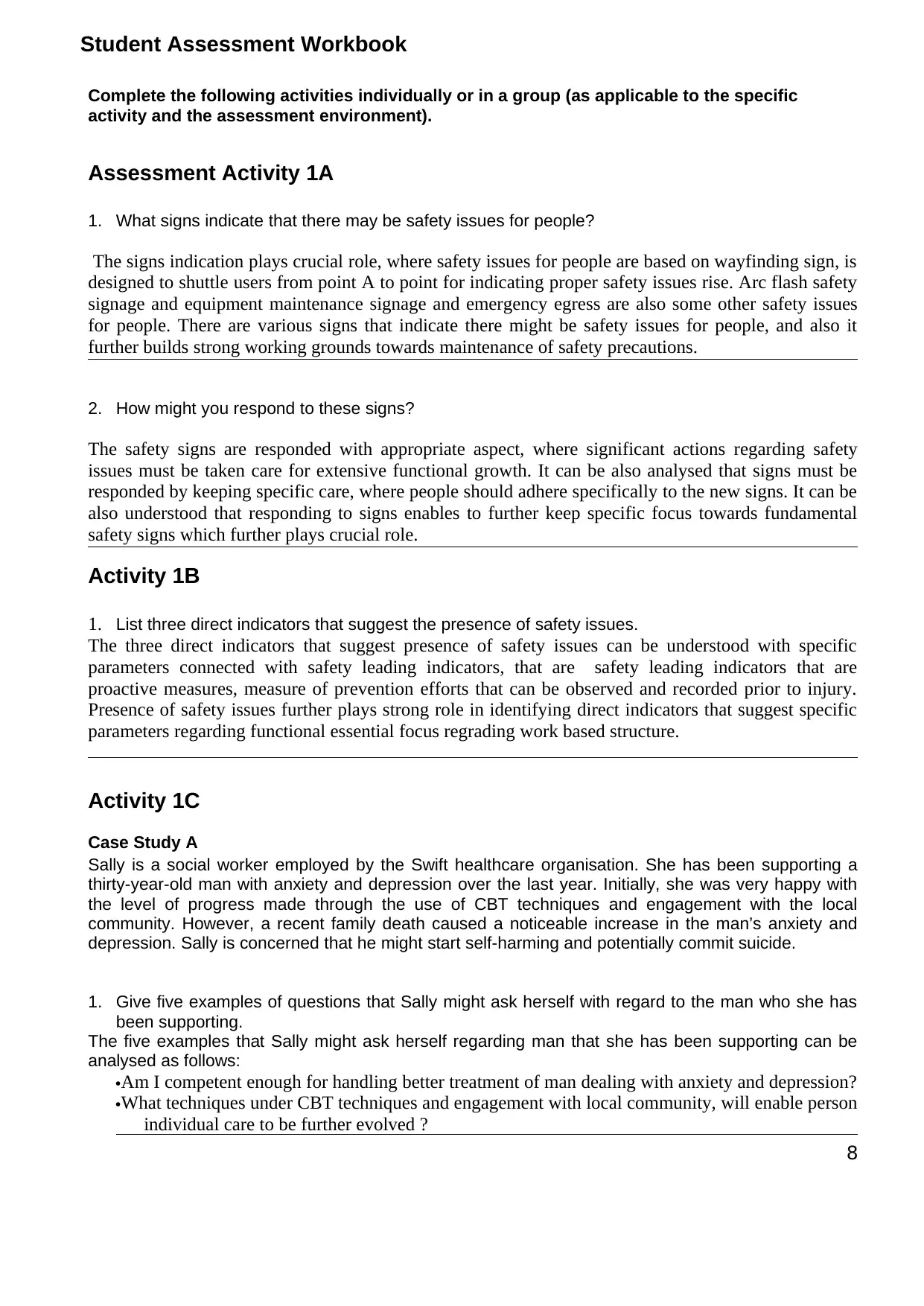
Student Assessment Workbook
Complete the following activities individually or in a group (as applicable to the specific
activity and the assessment environment).
Assessment Activity 1A
1. What signs indicate that there may be safety issues for people?
The signs indication plays crucial role, where safety issues for people are based on wayfinding sign, is
designed to shuttle users from point A to point for indicating proper safety issues rise. Arc flash safety
signage and equipment maintenance signage and emergency egress are also some other safety issues
for people. There are various signs that indicate there might be safety issues for people, and also it
further builds strong working grounds towards maintenance of safety precautions.
2. How might you respond to these signs?
The safety signs are responded with appropriate aspect, where significant actions regarding safety
issues must be taken care for extensive functional growth. It can be also analysed that signs must be
responded by keeping specific care, where people should adhere specifically to the new signs. It can be
also understood that responding to signs enables to further keep specific focus towards fundamental
safety signs which further plays crucial role.
Activity 1B
1. List three direct indicators that suggest the presence of safety issues.
The three direct indicators that suggest presence of safety issues can be understood with specific
parameters connected with safety leading indicators, that are safety leading indicators that are
proactive measures, measure of prevention efforts that can be observed and recorded prior to injury.
Presence of safety issues further plays strong role in identifying direct indicators that suggest specific
parameters regarding functional essential focus regrading work based structure.
Activity 1C
Case Study A
Sally is a social worker employed by the Swift healthcare organisation. She has been supporting a
thirty-year-old man with anxiety and depression over the last year. Initially, she was very happy with
the level of progress made through the use of CBT techniques and engagement with the local
community. However, a recent family death caused a noticeable increase in the man’s anxiety and
depression. Sally is concerned that he might start self-harming and potentially commit suicide.
1. Give five examples of questions that Sally might ask herself with regard to the man who she has
been supporting.
The five examples that Sally might ask herself regarding man that she has been supporting can be
analysed as follows:
Am I competent enough for handling better treatment of man dealing with anxiety and depression?
What techniques under CBT techniques and engagement with local community, will enable person
individual care to be further evolved ?
8
Complete the following activities individually or in a group (as applicable to the specific
activity and the assessment environment).
Assessment Activity 1A
1. What signs indicate that there may be safety issues for people?
The signs indication plays crucial role, where safety issues for people are based on wayfinding sign, is
designed to shuttle users from point A to point for indicating proper safety issues rise. Arc flash safety
signage and equipment maintenance signage and emergency egress are also some other safety issues
for people. There are various signs that indicate there might be safety issues for people, and also it
further builds strong working grounds towards maintenance of safety precautions.
2. How might you respond to these signs?
The safety signs are responded with appropriate aspect, where significant actions regarding safety
issues must be taken care for extensive functional growth. It can be also analysed that signs must be
responded by keeping specific care, where people should adhere specifically to the new signs. It can be
also understood that responding to signs enables to further keep specific focus towards fundamental
safety signs which further plays crucial role.
Activity 1B
1. List three direct indicators that suggest the presence of safety issues.
The three direct indicators that suggest presence of safety issues can be understood with specific
parameters connected with safety leading indicators, that are safety leading indicators that are
proactive measures, measure of prevention efforts that can be observed and recorded prior to injury.
Presence of safety issues further plays strong role in identifying direct indicators that suggest specific
parameters regarding functional essential focus regrading work based structure.
Activity 1C
Case Study A
Sally is a social worker employed by the Swift healthcare organisation. She has been supporting a
thirty-year-old man with anxiety and depression over the last year. Initially, she was very happy with
the level of progress made through the use of CBT techniques and engagement with the local
community. However, a recent family death caused a noticeable increase in the man’s anxiety and
depression. Sally is concerned that he might start self-harming and potentially commit suicide.
1. Give five examples of questions that Sally might ask herself with regard to the man who she has
been supporting.
The five examples that Sally might ask herself regarding man that she has been supporting can be
analysed as follows:
Am I competent enough for handling better treatment of man dealing with anxiety and depression?
What techniques under CBT techniques and engagement with local community, will enable person
individual care to be further evolved ?
8
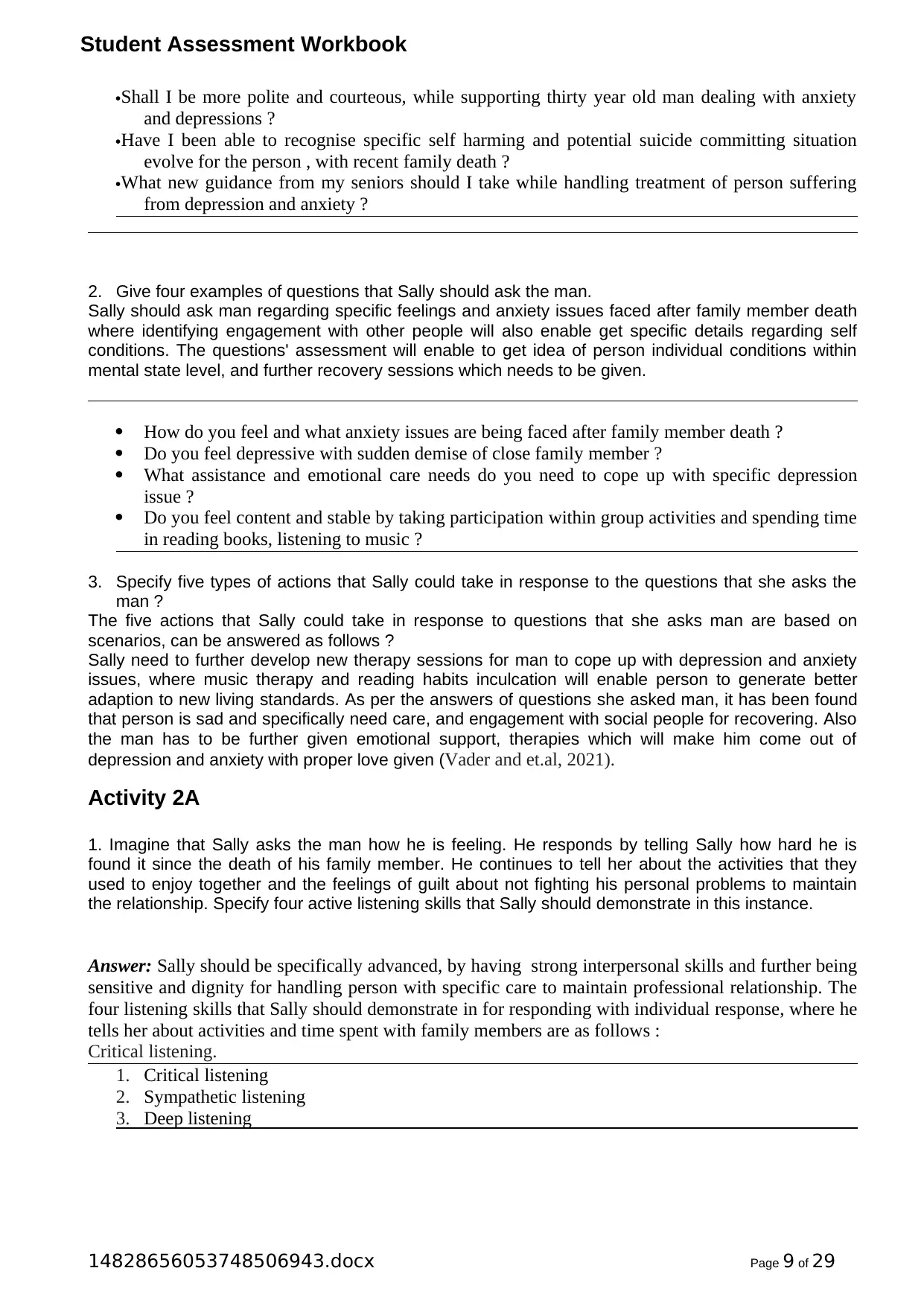
Student Assessment Workbook
Shall I be more polite and courteous, while supporting thirty year old man dealing with anxiety
and depressions ?
Have I been able to recognise specific self harming and potential suicide committing situation
evolve for the person , with recent family death ?
What new guidance from my seniors should I take while handling treatment of person suffering
from depression and anxiety ?
2. Give four examples of questions that Sally should ask the man.
Sally should ask man regarding specific feelings and anxiety issues faced after family member death
where identifying engagement with other people will also enable get specific details regarding self
conditions. The questions' assessment will enable to get idea of person individual conditions within
mental state level, and further recovery sessions which needs to be given.
How do you feel and what anxiety issues are being faced after family member death ?
Do you feel depressive with sudden demise of close family member ?
What assistance and emotional care needs do you need to cope up with specific depression
issue ?
Do you feel content and stable by taking participation within group activities and spending time
in reading books, listening to music ?
3. Specify five types of actions that Sally could take in response to the questions that she asks the
man ?
The five actions that Sally could take in response to questions that she asks man are based on
scenarios, can be answered as follows ?
Sally need to further develop new therapy sessions for man to cope up with depression and anxiety
issues, where music therapy and reading habits inculcation will enable person to generate better
adaption to new living standards. As per the answers of questions she asked man, it has been found
that person is sad and specifically need care, and engagement with social people for recovering. Also
the man has to be further given emotional support, therapies which will make him come out of
depression and anxiety with proper love given (Vader and et.al, 2021).
Activity 2A
1. Imagine that Sally asks the man how he is feeling. He responds by telling Sally how hard he is
found it since the death of his family member. He continues to tell her about the activities that they
used to enjoy together and the feelings of guilt about not fighting his personal problems to maintain
the relationship. Specify four active listening skills that Sally should demonstrate in this instance.
Answer: Sally should be specifically advanced, by having strong interpersonal skills and further being
sensitive and dignity for handling person with specific care to maintain professional relationship. The
four listening skills that Sally should demonstrate in for responding with individual response, where he
tells her about activities and time spent with family members are as follows :
Critical listening.
1. Critical listening
2. Sympathetic listening
3. Deep listening
14828656053748506943.docx Page 9 of 29
Shall I be more polite and courteous, while supporting thirty year old man dealing with anxiety
and depressions ?
Have I been able to recognise specific self harming and potential suicide committing situation
evolve for the person , with recent family death ?
What new guidance from my seniors should I take while handling treatment of person suffering
from depression and anxiety ?
2. Give four examples of questions that Sally should ask the man.
Sally should ask man regarding specific feelings and anxiety issues faced after family member death
where identifying engagement with other people will also enable get specific details regarding self
conditions. The questions' assessment will enable to get idea of person individual conditions within
mental state level, and further recovery sessions which needs to be given.
How do you feel and what anxiety issues are being faced after family member death ?
Do you feel depressive with sudden demise of close family member ?
What assistance and emotional care needs do you need to cope up with specific depression
issue ?
Do you feel content and stable by taking participation within group activities and spending time
in reading books, listening to music ?
3. Specify five types of actions that Sally could take in response to the questions that she asks the
man ?
The five actions that Sally could take in response to questions that she asks man are based on
scenarios, can be answered as follows ?
Sally need to further develop new therapy sessions for man to cope up with depression and anxiety
issues, where music therapy and reading habits inculcation will enable person to generate better
adaption to new living standards. As per the answers of questions she asked man, it has been found
that person is sad and specifically need care, and engagement with social people for recovering. Also
the man has to be further given emotional support, therapies which will make him come out of
depression and anxiety with proper love given (Vader and et.al, 2021).
Activity 2A
1. Imagine that Sally asks the man how he is feeling. He responds by telling Sally how hard he is
found it since the death of his family member. He continues to tell her about the activities that they
used to enjoy together and the feelings of guilt about not fighting his personal problems to maintain
the relationship. Specify four active listening skills that Sally should demonstrate in this instance.
Answer: Sally should be specifically advanced, by having strong interpersonal skills and further being
sensitive and dignity for handling person with specific care to maintain professional relationship. The
four listening skills that Sally should demonstrate in for responding with individual response, where he
tells her about activities and time spent with family members are as follows :
Critical listening.
1. Critical listening
2. Sympathetic listening
3. Deep listening
14828656053748506943.docx Page 9 of 29
⊘ This is a preview!⊘
Do you want full access?
Subscribe today to unlock all pages.

Trusted by 1+ million students worldwide
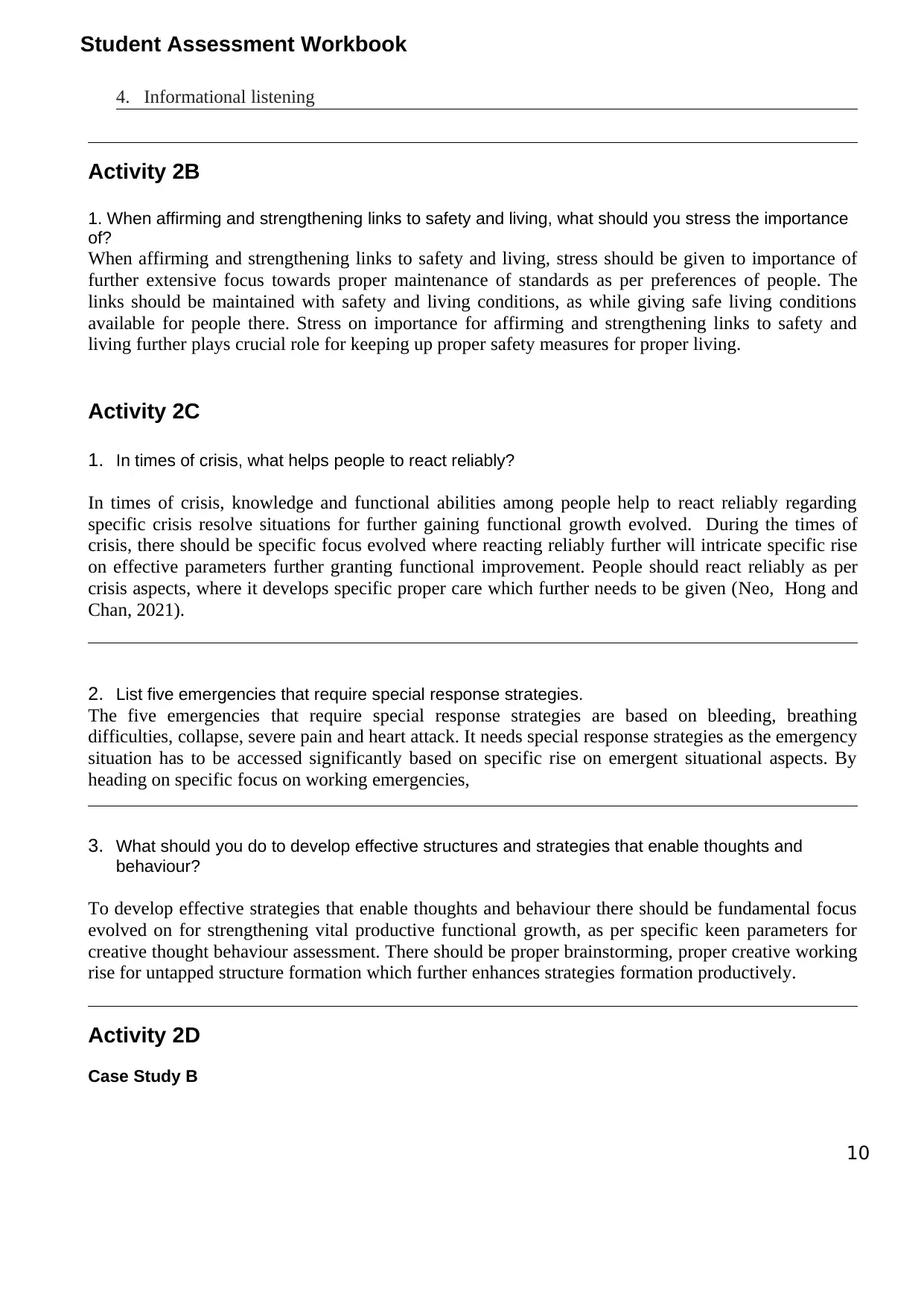
Student Assessment Workbook
4. Informational listening
Activity 2B
1. When affirming and strengthening links to safety and living, what should you stress the importance
of?
When affirming and strengthening links to safety and living, stress should be given to importance of
further extensive focus towards proper maintenance of standards as per preferences of people. The
links should be maintained with safety and living conditions, as while giving safe living conditions
available for people there. Stress on importance for affirming and strengthening links to safety and
living further plays crucial role for keeping up proper safety measures for proper living.
Activity 2C
1. In times of crisis, what helps people to react reliably?
In times of crisis, knowledge and functional abilities among people help to react reliably regarding
specific crisis resolve situations for further gaining functional growth evolved. During the times of
crisis, there should be specific focus evolved where reacting reliably further will intricate specific rise
on effective parameters further granting functional improvement. People should react reliably as per
crisis aspects, where it develops specific proper care which further needs to be given (Neo, Hong and
Chan, 2021).
2. List five emergencies that require special response strategies.
The five emergencies that require special response strategies are based on bleeding, breathing
difficulties, collapse, severe pain and heart attack. It needs special response strategies as the emergency
situation has to be accessed significantly based on specific rise on emergent situational aspects. By
heading on specific focus on working emergencies,
3. What should you do to develop effective structures and strategies that enable thoughts and
behaviour?
To develop effective strategies that enable thoughts and behaviour there should be fundamental focus
evolved on for strengthening vital productive functional growth, as per specific keen parameters for
creative thought behaviour assessment. There should be proper brainstorming, proper creative working
rise for untapped structure formation which further enhances strategies formation productively.
Activity 2D
Case Study B
10
4. Informational listening
Activity 2B
1. When affirming and strengthening links to safety and living, what should you stress the importance
of?
When affirming and strengthening links to safety and living, stress should be given to importance of
further extensive focus towards proper maintenance of standards as per preferences of people. The
links should be maintained with safety and living conditions, as while giving safe living conditions
available for people there. Stress on importance for affirming and strengthening links to safety and
living further plays crucial role for keeping up proper safety measures for proper living.
Activity 2C
1. In times of crisis, what helps people to react reliably?
In times of crisis, knowledge and functional abilities among people help to react reliably regarding
specific crisis resolve situations for further gaining functional growth evolved. During the times of
crisis, there should be specific focus evolved where reacting reliably further will intricate specific rise
on effective parameters further granting functional improvement. People should react reliably as per
crisis aspects, where it develops specific proper care which further needs to be given (Neo, Hong and
Chan, 2021).
2. List five emergencies that require special response strategies.
The five emergencies that require special response strategies are based on bleeding, breathing
difficulties, collapse, severe pain and heart attack. It needs special response strategies as the emergency
situation has to be accessed significantly based on specific rise on emergent situational aspects. By
heading on specific focus on working emergencies,
3. What should you do to develop effective structures and strategies that enable thoughts and
behaviour?
To develop effective strategies that enable thoughts and behaviour there should be fundamental focus
evolved on for strengthening vital productive functional growth, as per specific keen parameters for
creative thought behaviour assessment. There should be proper brainstorming, proper creative working
rise for untapped structure formation which further enhances strategies formation productively.
Activity 2D
Case Study B
10
Paraphrase This Document
Need a fresh take? Get an instant paraphrase of this document with our AI Paraphraser
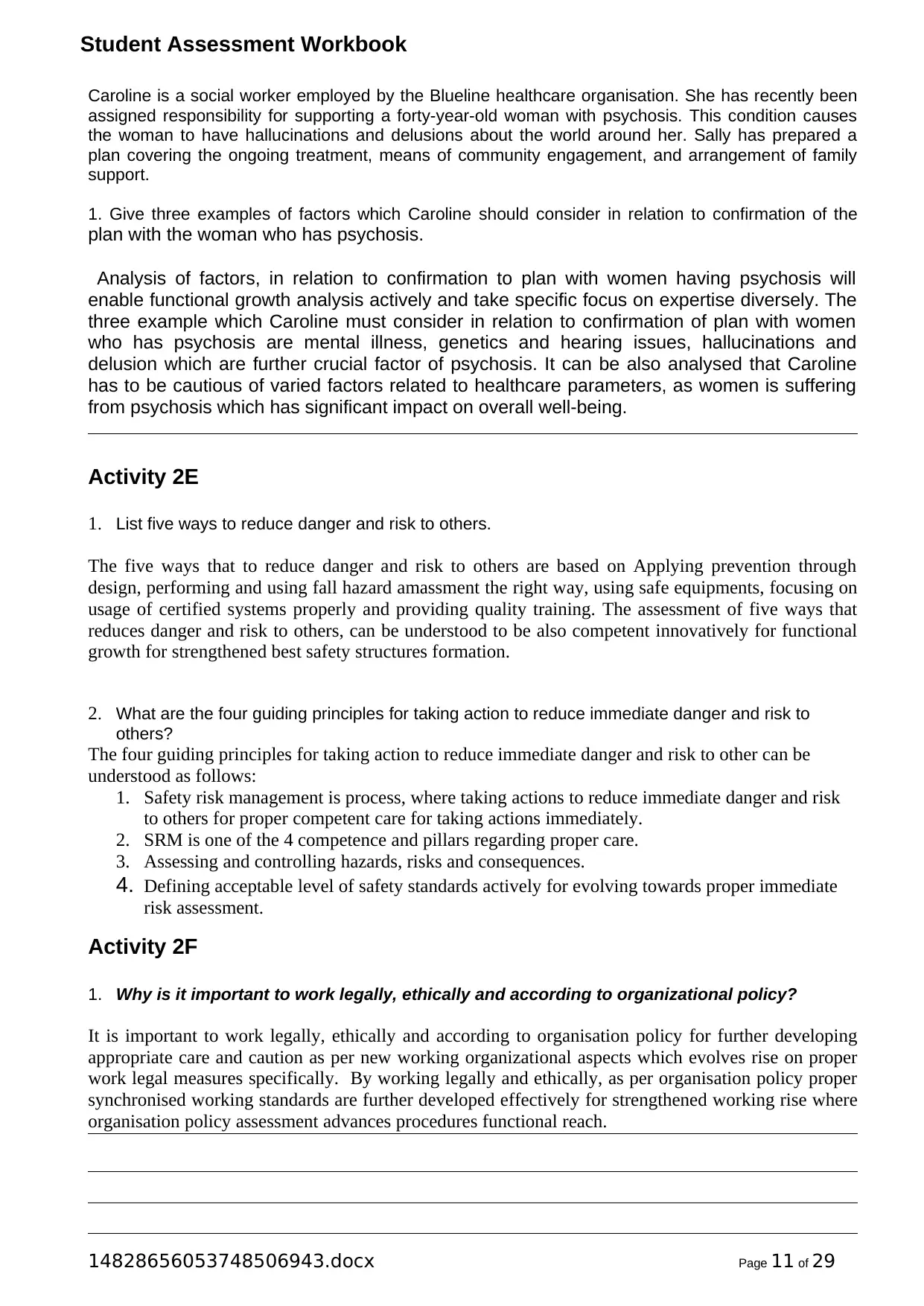
Student Assessment Workbook
Caroline is a social worker employed by the Blueline healthcare organisation. She has recently been
assigned responsibility for supporting a forty-year-old woman with psychosis. This condition causes
the woman to have hallucinations and delusions about the world around her. Sally has prepared a
plan covering the ongoing treatment, means of community engagement, and arrangement of family
support.
1. Give three examples of factors which Caroline should consider in relation to confirmation of the
plan with the woman who has psychosis.
Analysis of factors, in relation to confirmation to plan with women having psychosis will
enable functional growth analysis actively and take specific focus on expertise diversely. The
three example which Caroline must consider in relation to confirmation of plan with women
who has psychosis are mental illness, genetics and hearing issues, hallucinations and
delusion which are further crucial factor of psychosis. It can be also analysed that Caroline
has to be cautious of varied factors related to healthcare parameters, as women is suffering
from psychosis which has significant impact on overall well-being.
Activity 2E
1. List five ways to reduce danger and risk to others.
The five ways that to reduce danger and risk to others are based on Applying prevention through
design, performing and using fall hazard amassment the right way, using safe equipments, focusing on
usage of certified systems properly and providing quality training. The assessment of five ways that
reduces danger and risk to others, can be understood to be also competent innovatively for functional
growth for strengthened best safety structures formation.
2. What are the four guiding principles for taking action to reduce immediate danger and risk to
others?
The four guiding principles for taking action to reduce immediate danger and risk to other can be
understood as follows:
1. Safety risk management is process, where taking actions to reduce immediate danger and risk
to others for proper competent care for taking actions immediately.
2. SRM is one of the 4 competence and pillars regarding proper care.
3. Assessing and controlling hazards, risks and consequences.
4. Defining acceptable level of safety standards actively for evolving towards proper immediate
risk assessment.
Activity 2F
1. Why is it important to work legally, ethically and according to organizational policy?
It is important to work legally, ethically and according to organisation policy for further developing
appropriate care and caution as per new working organizational aspects which evolves rise on proper
work legal measures specifically. By working legally and ethically, as per organisation policy proper
synchronised working standards are further developed effectively for strengthened working rise where
organisation policy assessment advances procedures functional reach.
14828656053748506943.docx Page 11 of 29
Caroline is a social worker employed by the Blueline healthcare organisation. She has recently been
assigned responsibility for supporting a forty-year-old woman with psychosis. This condition causes
the woman to have hallucinations and delusions about the world around her. Sally has prepared a
plan covering the ongoing treatment, means of community engagement, and arrangement of family
support.
1. Give three examples of factors which Caroline should consider in relation to confirmation of the
plan with the woman who has psychosis.
Analysis of factors, in relation to confirmation to plan with women having psychosis will
enable functional growth analysis actively and take specific focus on expertise diversely. The
three example which Caroline must consider in relation to confirmation of plan with women
who has psychosis are mental illness, genetics and hearing issues, hallucinations and
delusion which are further crucial factor of psychosis. It can be also analysed that Caroline
has to be cautious of varied factors related to healthcare parameters, as women is suffering
from psychosis which has significant impact on overall well-being.
Activity 2E
1. List five ways to reduce danger and risk to others.
The five ways that to reduce danger and risk to others are based on Applying prevention through
design, performing and using fall hazard amassment the right way, using safe equipments, focusing on
usage of certified systems properly and providing quality training. The assessment of five ways that
reduces danger and risk to others, can be understood to be also competent innovatively for functional
growth for strengthened best safety structures formation.
2. What are the four guiding principles for taking action to reduce immediate danger and risk to
others?
The four guiding principles for taking action to reduce immediate danger and risk to other can be
understood as follows:
1. Safety risk management is process, where taking actions to reduce immediate danger and risk
to others for proper competent care for taking actions immediately.
2. SRM is one of the 4 competence and pillars regarding proper care.
3. Assessing and controlling hazards, risks and consequences.
4. Defining acceptable level of safety standards actively for evolving towards proper immediate
risk assessment.
Activity 2F
1. Why is it important to work legally, ethically and according to organizational policy?
It is important to work legally, ethically and according to organisation policy for further developing
appropriate care and caution as per new working organizational aspects which evolves rise on proper
work legal measures specifically. By working legally and ethically, as per organisation policy proper
synchronised working standards are further developed effectively for strengthened working rise where
organisation policy assessment advances procedures functional reach.
14828656053748506943.docx Page 11 of 29
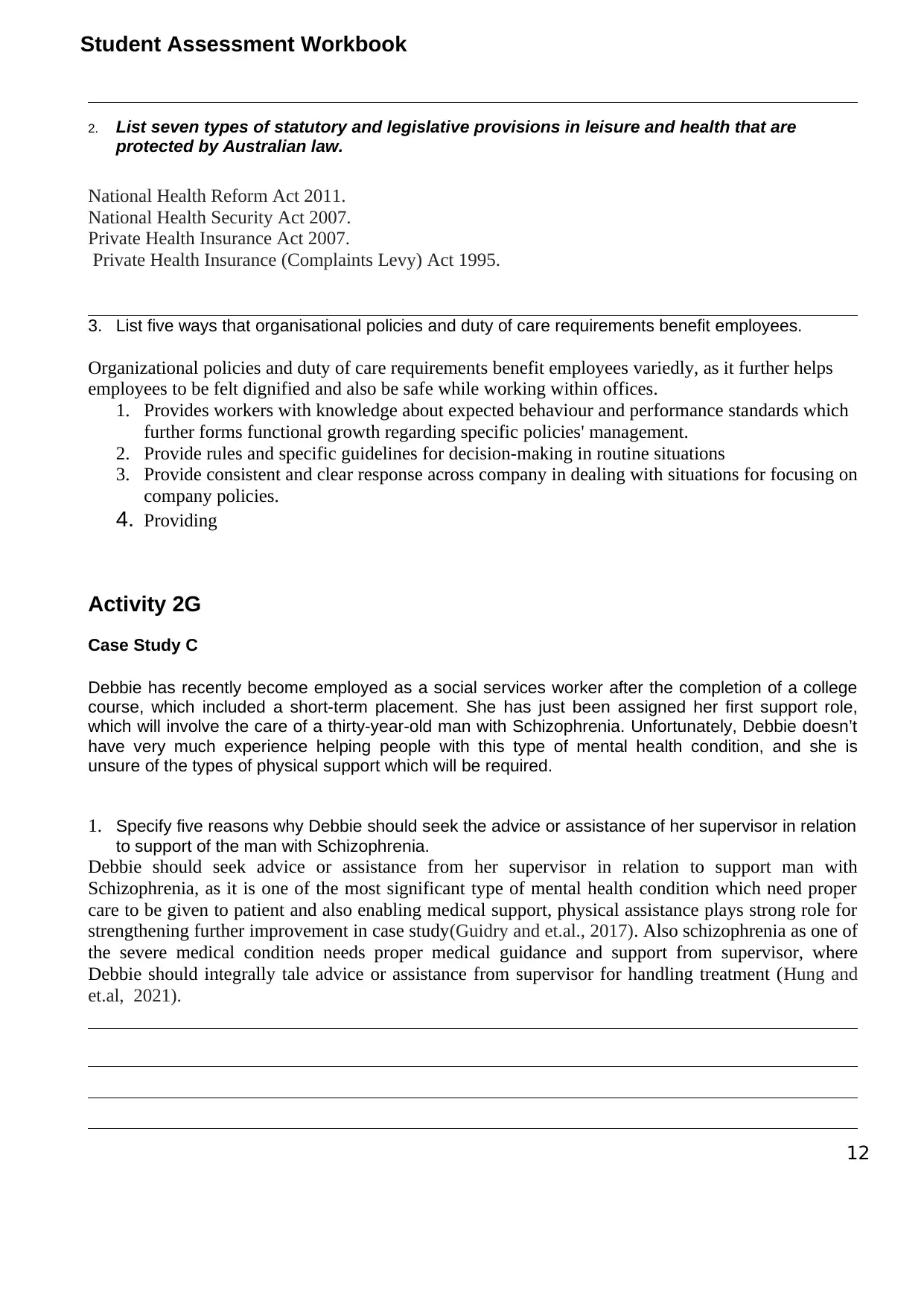
Student Assessment Workbook
2. List seven types of statutory and legislative provisions in leisure and health that are
protected by Australian law.
National Health Reform Act 2011.
National Health Security Act 2007.
Private Health Insurance Act 2007.
Private Health Insurance (Complaints Levy) Act 1995.
3. List five ways that organisational policies and duty of care requirements benefit employees.
Organizational policies and duty of care requirements benefit employees variedly, as it further helps
employees to be felt dignified and also be safe while working within offices.
1. Provides workers with knowledge about expected behaviour and performance standards which
further forms functional growth regarding specific policies' management.
2. Provide rules and specific guidelines for decision-making in routine situations
3. Provide consistent and clear response across company in dealing with situations for focusing on
company policies.
4. Providing
Activity 2G
Case Study C
Debbie has recently become employed as a social services worker after the completion of a college
course, which included a short-term placement. She has just been assigned her first support role,
which will involve the care of a thirty-year-old man with Schizophrenia. Unfortunately, Debbie doesn’t
have very much experience helping people with this type of mental health condition, and she is
unsure of the types of physical support which will be required.
1. Specify five reasons why Debbie should seek the advice or assistance of her supervisor in relation
to support of the man with Schizophrenia.
Debbie should seek advice or assistance from her supervisor in relation to support man with
Schizophrenia, as it is one of the most significant type of mental health condition which need proper
care to be given to patient and also enabling medical support, physical assistance plays strong role for
strengthening further improvement in case study(Guidry and et.al., 2017). Also schizophrenia as one of
the severe medical condition needs proper medical guidance and support from supervisor, where
Debbie should integrally tale advice or assistance from supervisor for handling treatment (Hung and
et.al, 2021).
12
2. List seven types of statutory and legislative provisions in leisure and health that are
protected by Australian law.
National Health Reform Act 2011.
National Health Security Act 2007.
Private Health Insurance Act 2007.
Private Health Insurance (Complaints Levy) Act 1995.
3. List five ways that organisational policies and duty of care requirements benefit employees.
Organizational policies and duty of care requirements benefit employees variedly, as it further helps
employees to be felt dignified and also be safe while working within offices.
1. Provides workers with knowledge about expected behaviour and performance standards which
further forms functional growth regarding specific policies' management.
2. Provide rules and specific guidelines for decision-making in routine situations
3. Provide consistent and clear response across company in dealing with situations for focusing on
company policies.
4. Providing
Activity 2G
Case Study C
Debbie has recently become employed as a social services worker after the completion of a college
course, which included a short-term placement. She has just been assigned her first support role,
which will involve the care of a thirty-year-old man with Schizophrenia. Unfortunately, Debbie doesn’t
have very much experience helping people with this type of mental health condition, and she is
unsure of the types of physical support which will be required.
1. Specify five reasons why Debbie should seek the advice or assistance of her supervisor in relation
to support of the man with Schizophrenia.
Debbie should seek advice or assistance from her supervisor in relation to support man with
Schizophrenia, as it is one of the most significant type of mental health condition which need proper
care to be given to patient and also enabling medical support, physical assistance plays strong role for
strengthening further improvement in case study(Guidry and et.al., 2017). Also schizophrenia as one of
the severe medical condition needs proper medical guidance and support from supervisor, where
Debbie should integrally tale advice or assistance from supervisor for handling treatment (Hung and
et.al, 2021).
12
⊘ This is a preview!⊘
Do you want full access?
Subscribe today to unlock all pages.

Trusted by 1+ million students worldwide
1 out of 29
Related Documents
Your All-in-One AI-Powered Toolkit for Academic Success.
+13062052269
info@desklib.com
Available 24*7 on WhatsApp / Email
![[object Object]](/_next/static/media/star-bottom.7253800d.svg)
Unlock your academic potential
Copyright © 2020–2025 A2Z Services. All Rights Reserved. Developed and managed by ZUCOL.





